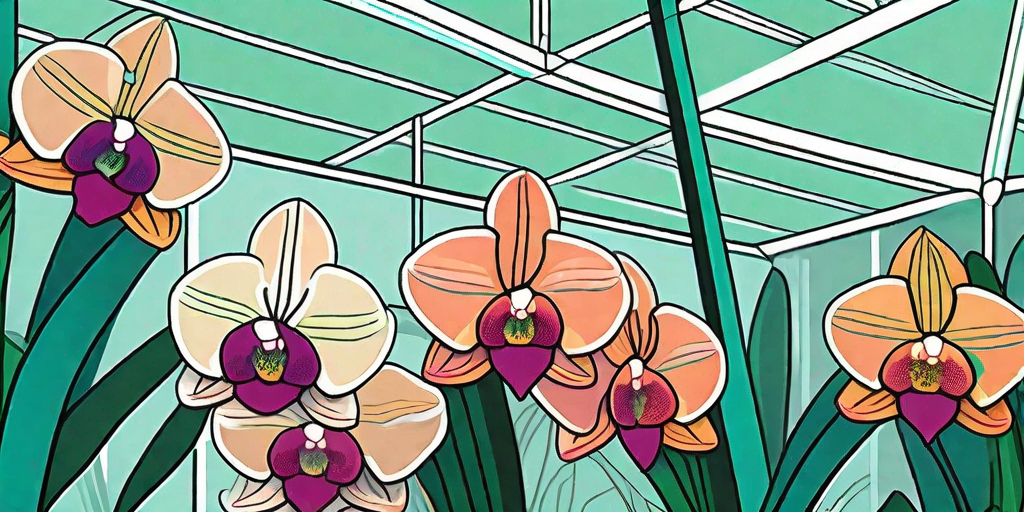
Vanda orchids, with their vibrant colors and exotic patterns, are the divas of the orchid world. They demand attention, and rightly so. These tropical beauties are not the easiest to care for, but with the right knowledge and a bit of cheeky humor, you can turn your home into a Vanda paradise. So, buckle up, green thumbs, as we dive into the captivating world of Vanda orchids.
The Vanda Orchid: A Brief Introduction
Originating from the warm and humid regions of Asia, Vanda orchids are known for their large, robust blooms and aerial roots. They are epiphytes, meaning they grow on trees, and their roots are exposed to the air. Now, don't get any ideas about tying your Vanda to the nearest oak tree. They prefer the cozy indoors, thank you very much.
There are about 80 species of Vanda orchids, each more stunning than the last. From the deep blues of Vanda coerulea to the vibrant yellows of Vanda denisoniana, these orchids are a feast for the eyes. But enough of the chit-chat, let's get down to business.
How to Grow Vanda Orchids
Now, growing Vanda orchids is not for the faint-hearted. They require a bit of elbow grease, but the reward is well worth the effort. So, roll up your sleeves and let's get started.
Light Requirements
Vanda orchids are the sun-worshippers of the orchid world. They love bright, indirect light. A south-facing window is ideal, but if your home is more cave-like, fret not. A grow light can do the trick. Just remember, too much direct sunlight can turn your Vanda into a crispy critter. Balance is key.
Watering and Humidity
Coming from tropical regions, Vanda orchids love humidity. A humidity tray or a room humidifier can help maintain the moisture levels. As for watering, these divas like their drinks. Water them thoroughly until the roots turn green, then let them dry before the next watering. Remember, they hate soggy feet.
Temperature and Air Circulation
Vanda orchids prefer warm temperatures, ideally between 70 to 95 degrees Fahrenheit during the day and 60 to 70 degrees at night. They also appreciate good air circulation, so a gentle fan can be beneficial. Just don't turn your home into a wind tunnel.
Caring for Vanda Orchids
Now that you've got the basics down, let's delve into the nitty-gritty of Vanda care.
Feeding Your Vanda
Vanda orchids are heavy feeders. A balanced orchid fertilizer, applied weekly, can keep them happy. Just remember to flush the roots with plain water once a month to prevent salt buildup. After all, no one likes a salty orchid.
Repotting and Mounting
Unlike other orchids, Vandas don't like to be confined to a pot. They prefer to be mounted on a slab of bark or grown in a basket where their roots can hang freely. If you do decide to pot them, use a coarse, well-draining medium and a pot with plenty of holes. Remember, these divas need their space.
Common Problems and Solutions
Like any diva, Vanda orchids can be a bit temperamental. Here are some common problems and how to fix them.
Yellow Leaves
Yellow leaves can be a sign of too much light. If your Vanda is looking more sunburned than sun-kissed, move it to a shadier spot or provide some shade.
Root Rot
If the roots are turning black and mushy, it's a sign of overwatering. Cut back on the water and let the roots dry out between watering.
Pests
Vanda orchids can be prone to pests like scale and mealybugs. If you spot these unwelcome guests, treat your orchid with a gentle insecticide or a mixture of water and dish soap.
Frequently Asked Questions
- How often should I water my Vanda orchid?
Water your Vanda orchid when the roots turn a silvery color. This could be every day in hot, dry conditions or every few days in cooler, humid conditions.
- Why are my Vanda orchid's leaves wrinkled?
Wrinkled leaves can be a sign of underwatering or low humidity. Increase the watering frequency and consider using a humidity tray or room humidifier.
- How often should I feed my Vanda orchid?
Vanda orchids are heavy feeders and benefit from weekly feeding with a balanced orchid fertilizer. Remember to flush the roots with plain water once a month to prevent salt buildup.
There you have it, folks. A comprehensive guide to growing and caring for Vanda orchids. With a bit of patience and a dash of humor, you can transform your home into a tropical paradise. So, go on, unleash the beauty of Vanda orchids and let these stunning flowers steal the show.















